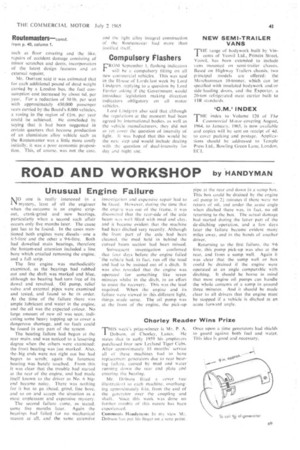ROAD AND WORKSHOP by HANDYMAN
Page 43

If you've noticed an error in this article please click here to report it so we can fix it.
Unusual Engine Failure
KJO one is really interested in a
'4/ mystery, least of all the engineer when the outcome is an engine stripout, crank-grind and new bearings, particularly when a "second such affair occurs only five months later. The cause just has to be found.. In the cases mentioned both engines were diesels—one a 6.5-litre and the other a' 9.6-litre. Both had dowelled main bearings, therefore the bottom-end attention included a line bore which entailed removing the engine. and a full strip.
The first engine was methodically examined, as the bearings had rubbed out and the shaftewas marked and blue, although no bearing had torn free of its dowel and revolVed. Oil pump, relief valve and external pipes were examined and tested, and found to be in order. At the time of the failure there was ample lubricant and water in the engine. and the oil was the expected colour. No large amount of new oil was seen, indicating some heavy topping up to cover a dangerous shortage, and no fault could be. found in any part of the system.
The bearing failure had begun at the rear main, and was noticed to a lessening degree when the others were examined: the front bearing was just marked. Also, the.big ends were not right out but had begun to scrub: again the foremost bearing was barely touched. From this it was clear that the trouble had started at the rear of the engine, and had made itself known to the driver a,s No. 6 bigend became noisy. There was nothing for it but to go ahead, grind, line bore, and so on and accept the situation as a most unpleasant and expensive mystery.
The second failure came, as stated. some five months later. Again the bearings had failed for no mechanical reason at all, and the same extensive investigation and expensive repair had to be faced. However, during the time that the engi;le was out of the frame, it was discovered that the rear-side of the axle beam was well filled With mud and clay, and it became evident that the machine had been ditched very recently. Although the front part of the axle had been cleaned, the mild held in behind the curved beam section had been missed.
So 1,SC‘I LK'.n t investigation con ti rmed that our days before the engine failed • the vehicle had, in fact, run off the road and had to be assisted out of a ditch. It Was also revealed that the engipe. was Operated for .something like seven minutes whilst in the ditch, in an effort to assist the recovery. This was the lead required. When the engine and its failure %Acre vie-wed in this different light, things made sense. The oil pump was at the front of the engine, ihe pick-up
pipe at the rear and down in a sump box. This box could be drained by the engine oil pump in 21 minutes if there were no return' of oil, and under the acute angle when ditched there was, in fact, no oil returning to the box. The actual damage had started during the latter part of the de-ditching operation, and a few days later the failure became evident many • miles away, and in the hands of another driver. .
Returning to the first failure, the 9.6 litre, this pump pick-up was also at the rear, and from a sump well. Again it was clearthat the sturip well or box could he drained if the engine were operated at an angle comparable with ditching, It should he borne in mind that most engine oil pumps can handle the whole contents of a sump in around three minutes. And it should be made clear to all drivers that the engine must be stopped if a vehicle is ditched at an acute forward angle.
























































































































